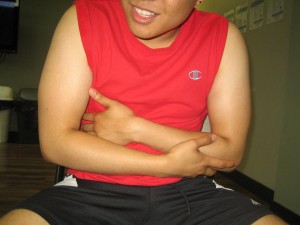An anal fissure is defined as tearing in the lining of the anus or anal canal. In most cases, a fissure can cause pain and even bleed.
What are the causes?
The fissures can be brought about by trauma to the anus and anal canal. The root of the trauma can include any of the following:
- Prolonged episodes of diarrhea
- Chronic constipation
- Straining during bowel movement particularly in cases where the stool is large, dry and/or large
- Anal stretching
- Inserting foreign objects into the anus
Aside from trauma, other possible causes include:
- Long-lasting poor bowel habits
- Scarring within the anorectal region
- Taut or spastic anal sphincter muscles
- Reduced blood flow to the anorectal region
Pain or discomfort during and even hours after a bowel movement. - Certain underlying conditions such as ulcerative colitis, Crohn’s disease, anal cancer, tuberculosis and sexually transmitted disease such as gonorrhea or syphilis.
An anal fissure is also likely to form among women after childbirth as well as in young infants.
What are the signs?
If an individual has an anal fissure, the following signs might be present:
- Constipation
- Pain or discomfort during and even hours after a bowel movement
- Blood on the exterior surface of the stool
- Evident crack or tearing in the anal canal or anus
- Blood-streaked wipes or toilet tissue
- Itchiness and burning sensation
- Discomfort while urinating, inability to urinate or frequent urination
- Foul-smelling drainage
Management of an anal fissure
The objective of treatment for an anal fissure is to reduce the pressure on the anal canal by making the stools soft as well as relieving the discomfort and bleeding.
The conservative measures are utilized first which includes:
- Prevention of constipation with the help of stool softeners, increased intake of fluids, avoidance of caffeine-based products and dietary modifications.
- Soaking in a warm bath 10-20 minutes several times throughout the day to allow the anal muscles to relax.
- Cleansing of the anorectal region in a gentle manner
- Avoid straining or prolonged sitting on the toilet
- Apply petroleum jelly to lubricate the anorectal region
In most cases, these conservative measures can help an anal fissure heal within several weeks to months. Nevertheless, if these measures fail or the fissures persist, these measures are often suggested:
- Hydrocortisone-based suppositories, creams or foams to lessen the inflammation
- Application of other creams and ointments such as a topical muscle relaxant, medicated cream for healing, anesthetic ointment and nitroglycerin or calcium channel blocker ointments
- Injection of botulinum toxin type A into the anal sphincter which briefly paralyzes the anal sphincter muscle to lessen the pain and promote healing
- Surgical intervention

